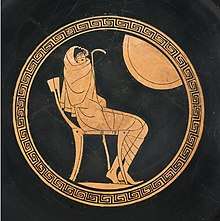Himation
A himation (Ancient Greek: ἱμάτιον, /hɪˈmætiˌɒn/, hə-MAT-ee-un[1]) was a type of clothing, a mantle or wrap worn by ancient Greek men and women from the Archaic through the Hellenistic periods (c. 750–30 BC).


It was usually worn over a chiton and/or peplos, but was made of heavier drape and played the role of a cloak or shawl. When the himation was used alone (without a chiton), and served both as a chiton and as a cloak, it was called an achiton. The himation was markedly less voluminous than the Roman toga. It was usually a large rectangular piece of woollen cloth. Many vase paintings depict women wearing a himation as a veil covering their faces.[2]
The himation continued into the Byzantine era as "iconographic dress" used in art, worn by Christ, the Virgin Mary, and biblical figures.
See also
References
- "HHimation". Merriam-Webster.
- Renshaw, James (2008). In Search of the Greeks. London: Bristol Classical Press. p. 157. ISBN 978-1-8539-9699-3.
